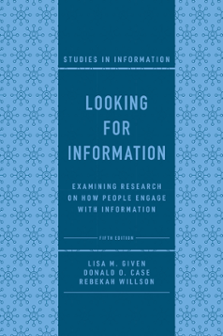Ignoring. See also Avoidance; Selective exposure
, 4, 146, 245
Image as information structure
, 6, 34, 51, 76, 87, 212
Impact, social
, 14–15, 37, 41, 85, 93, 99, 198–200, 240–241, 243–244, 249, 252–253
In-depth interviews. See Interviews
Information
, 1–3, 5–8
definitions of
, 6
behavior, definition of
, 6
campaigns
, 10
creation
, 4, 17–18, 52, 80, 142, 149, 181–182, 203, 210, 248
experience
, 1–2, 4, 9, 11, 47, 52, 71–72, 82, 94, 237–238, 241–242, 244, 248–249
functions
, 40, 79
grounds
, 92, 97
horizon maps
, 40, 207
information-resource problems
, 41
literacy
, 132–136, 216, 240
managing
, 39, 41, 44, 91
needs. See Information needs
overload
, 50, 89, 96
practice
, 1, 74, 79–80, 89, 97, 136, 148–149, 211–212, 214–215
quality
, 6, 82, 94
seeking. See Information seeking
sharing
, 4, 17, 37, 41–42, 45, 52, 75–78, 88–89, 144, 149, 185, 187, 217
sources
, 2–3, 9, 12–13, 17, 29, 40–41, 43, 50, 54, 87–88, 92–95, 98, 132–133, 151, 154, 156, 183, 185–186, 202, 207, 210, 211, 215, 219–220, 241
use
, 2, 4, 8, 12, 14–15, 31, 33, 35, 46, 71–72, 78–80, 82, 93, 127, 146, 149, 214
Information needs
, 8–9, 12, 14, 26–33
historic approaches to studying
, 33–54
trouble with
, 30–32
and uses research
, 9, 25, 201
Information Search Process model (ISP model)
, 86, 147
Information seeking
, 1, 4, 5, 9, 10–12, 14–15, 24, 26–33
historic approaches to studying
, 33–54
motivations for
, 27, 30
Information Seeking and Communication Model (ISCM)
, 151
Information Seeking in Context (ISIC)
, 75, 243
Intention
, 6–7, 12, 76, 133, 139, 151, 186, 195, 219–220
Internet
, 2–3, 5, 16, 28, 37, 41, 45, 48, 50, 53–54, 73, 82–84, 88, 91–94–95, 97–98, 141, 143, 152, 185–186, 196, 214–215, 248
Interpersonal communication
, 38, 43, 83
Interpersonal information seeking
, 43, 76
Interpretivist theories
, 133–141
constructivism. See also Constructivism
, 136–138
phenomenology. See also Phenomenology
, 138–139
social constructionism. See also Social constructionism
, 134–136
structuration, face theory, critical theory, reader response
, 139–141
Interviews
, 15, 24, 34, 37, 39–41, 43–44, 46, 50, 51–54, 87, 89, 91–94–95, 139, 148, 184, 189, 191, 194, 200–201, 204–208, 211–212, 215–218, 220
